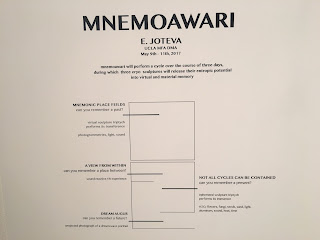DESMA 9 Event 5 ---- Fowler Museum
Last week I visited the Fowler Museum on campus. I had a great time and I am thankful that this class coaxed me to go or else I may never have gone. I think this museum will definitely benefit a student of DESMA 9 because you can see both how ancient and medical technology can be incorporated into art. I will definitely be going back in the future!
While I enjoyed looking through all the exhibits, I think only a few truly applied to the concepts of the course. I now want to show you a few pieces of art that I found especially applicable. The first is a mannequin with the spine exposed and no head included. I thought this was an interesting crossover between medicine and art. Just as Dr. Vesna stated in her lecture, dissection was the first connection between these two realms of study. This work uses dissection for a purely artistic purpose. The folded out torso exposing the spine conjures ideas of how simple humans are: just skin wrapped around a vertebral column.
.JPG) |
| Spine 2013 |
Next, I came across an article of clothing hanging from the ceiling that looked like a jumpsuit. It was made of nylon with many outer compartments and had a zipper going down the center. Within each compartment were colorful pills. In this piece Sundaram uses an aspect of medicine to make commentary on society. Since the pills are located all throughout the body I believe the artist is claiming that today's society consumes too many prescribed medications.
.JPG) |
| Pill-fill 2011 |
There was one other exhibit that was also relevant to course material; it contained ancient tools and relics made by indigenous people. I learned that the Yami people of Botel Tobago, an island about forty-five miles off the coast of Taiwan, relied on fishing in open-ocean canoes. As can be seen in the picture below, a strong effort was made to make the canoe look aesthetically pleasing with the symbols carved into the side of the boat and shapes attached to the ends, while still allowing it to be useful for performing a job. Thus the rise of technology is not inhibitory to art, I believe this is an example where more artful forms can be more practically useful. For instance the sharp, narrow design of the boat is sleek, but would also cut through the water more effectively.
.JPG) |
| Tatara made by the Yami Peoples of Botel Tobago Island |
Additionally, there was one case that was full of ancient head rests/pillows. Once again there was a clear attention to artistic detail while at the same time creating something for functional use. It was interesting to see that multiple civilizations from Rendille, to Teke, to Luba to Old Kingdom Egypt came up with similar ideas of what represents status and a bridge to ancestral realms.
 |
| "Pillows" From Multiple Civilizations |



Comments
Post a Comment